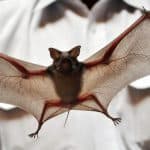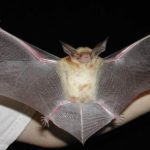Votre panier est actuellement vide !

The bat
The only mammal capable of flight. Hairy body, membranous wings that attach the arms to the hind legs. Large ears, rests head down. The little brown bat, a medium-sized species from Canada, weighs about 8 grams (the mass of two nickels and a dime) and has a wingspan of about 22 cm. The hoary bat, at 30 grams with a wingspan of 40 cm, is the largest of the Canadian species.
Latin Name: vespertilio
Description:Small mammal.Only mammal capable of flight.Hairy body, membranous wings that attach the arms to the hind legs.Large ears, rests head down.The little brown bat, a medium-sized species of Canada, weighs about 8 gen summer (the mass of two nickels and a dime) and the wingspan is about 22 cm. The hoary bat, at 30 grams with a wingspan of 40 cm, is the largest of Canada’s species, and lives for up to 35 years. Most bats – and all species in Canada – use the echo of the sounds they make to locate objects in their path. High-pitched sounds have shorter wavelengths than low-pitched sounds and give bats more detailed information about their target.The calls of most species of bats in Canada are ultrasonic (inaudible to the human ear)19 species live in Canada8 in Quebec
Reproduction:In early August, adult males travel each night to the caves and mines that will serve as hibernation sites. They arrive at these locations after feeding and spend several hours underground. As August progresses, more adult females and juveniles join the males at the hibernation sites; the first mating occurs in mid-August.Most mating occurs before the number of hibernating bats increases in September.Females store sperm in their uteri throughout the winter; ovulation and fertilization occur when they emerge from hibernation in the spring. Pregnant females of most Canadian species gather in April or May in the warmest roosts in buildings or hollow trees. A single colony may contain several hundred little bats. It is in these maternity colonies that the young are born around mid-June, 50 to 60 days after fertilization, and it is there that they are raised.Each female bat gives birth to a single young.The females leave their young in the roosting area each night when they go out to look for food. When they return, the mothers are sure to find their own young among the many others waiting in the maternity colony.Little bat pups fly at 18 days of age, by which time they have lost their milk teeth and have begun to consume insects, in addition to feeding on the mother’s milk. In July and August, females and young feed heavily as they build up fat reserves in preparation for hibernation.We know relatively little about the lives of adult males in summer.They do not live in maternity colonies with females and young, and we assume that they roost alone or in small groups in cracks and crevices.
Habits:In Canada, bats feed on insects, usually those they catch in flight, including moths, beetles, mayflies, caddisflies and midges. Insectivorous species typically consume between 50 percent and more than 100 percent of their body mass in insects during each summer night. This is equivalent, for a 60 kg person, to consuming 30 kg to 60 kg of food in a single day.A bat’s summer sleep is punctuated by twenty hours of sleep for every four hours of nighttime hunting. During the summer, individuals of some bat species gather in colonies, while others live alone.In the first group, there are species that roost in buildings, such as the little brown bat, the big brown bat and the Yuma bat. In the second group, there are species that sleep in trees or climbing plants, such as the red bat and hoary bat. Other species, such as the pallid bat and spotted bat, prefer cracks and crevices in cliffs. In the fall in Canada, when weather conditions become more severe and insects become less abundant, bats combine migration and hibernation. Some common building-roosting species, including little brown bats and big brown bats, migrate to hibernation sites that vary in distance: little brown bats may travel hundreds of kilometers and big brown bats tens of kilometers. Bats generally hibernate underground, often in caves or abandoned mines, where temperatures are stable and above freezing and humidity is very high. Other species, such as the red bat, hoary bat, and silver bat, migrate to more southern locations, where they may hibernate in hollow trees or layers of dead leaves (red bat)or remain active.
Prevention:The bat is a mammal and can transmit rabies, in the case of a bite,seek medical attention promptly.Bats are very useful animals and one should try to cohabit with them rather than eliminate them. If a colony has established itself in your home and you find it disturbing, we suggest that you consult a pest management specialist. This professional will know how to remove the colony from your home in a way that minimizes the mortality rate of the bats.
